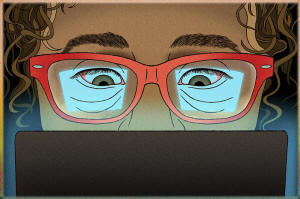Screen breaks and the right desk setup offer relief from work-related
eye strain
 Send a link to a friend
Send a link to a friend
 [January 24, 2025]
By CATHY BUSSEWITZ [January 24, 2025]
By CATHY BUSSEWITZ
NEW YORK (AP) — The trouble started every day at around 3 p.m., after
Cathy Higgins had spent five or six hours staring at an array of
computer screens at her desk. Her university job overseeing research
projects involved peering closely at numbers and details on contracts,
applications and budgets.
“My vision was so blurry, I couldn’t even see what was on the screen,
and I was squinting so much that I could not function,” Higgins said.
When her eyesight got bad, Higgins walked around and spoke with members
of her staff. She began planning in-person meetings for afternoons. But
she would resume the computer work late at night after her children went
to bed.
“If I had to continue working through the blurry vision, that’s when the
migraines would happen,” Higgins said.
Digital screens are pervasive, not only at work but in our homes,
schools and shops. An estimated 104 million Americans of working age
spend more than seven hours a day in front of screens, according to the
American Optometric Association. All that screen time can take a toll.
Too much exposure to screens can lead to dry or watery eyes, fuzzy
vision and headaches. It can also lead to myopia, or nearsightedness, in
some people, especially children. Some technology workers even describe
short bouts of vertigo when they look at screens for too long.

Overworked eyes
One reason for the discomfort is that staring closely at screens for
prolonged periods causes the muscle that helps eye focus to tighten up.
“That muscle's not supposed to stay tight all day long. And if it does,
it's like picking up a light weight and trying to hold it over your head
for hours,” American Optometric Association President Steven Reed said.
“It’s not hard to pick it up. But after a while, even though it’s not a
heavy lift, your body just gets tired.”
Fortunately, exposure to blue light from computer screens and devices
has not been shown to cause permanent eye damage, according to the
American Academy of Opthalmology.
Nevertheless, symptoms can disrupt work, family time and rest. As an
optometrist in Mississippi, Reed sees patients who complain of frequent
eye pain, headaches and blurry vision associated with computer use. He
advises getting an eye exam and taking frequent breaks.
For Higgins, trying to catch up on the work she couldn't do when her
eyes were too fatigued on weekdays cut into time she spent with her
daughters on weekends. “They’d be playing together, and I couldn’t be as
engaged as I would have liked to have been in what they were doing,” she
said.
Here are some tips from eye health professionals to reduce eye strain
caused by devices.
Follow the 20-20-20 rule
Take a break every 20 minutes from sitting at a computer. During the
break, focus your eyes on something that's about 20 feet away for 20
seconds. Pausing close-up work and looking at something in the distance
gives tired, tight muscles time to relax.
“Luckily, eye strain is temporary,” said Raj Maturi, an ophthalmologist
at Midwest Eye Institute in Indianapolis who serves as spokesperson for
the American Academy of Ophthalmology. “The best way to avoid these
symptoms is by taking breaks from our screens or near work activities
and using lubricating eye drops, if needed.”

[to top of second column]
|

AP Illustration / Annie Ng
 People usually blink about 18 to 22
times per minute. But when looking at a screen, the rate drops to
three to seven times per minute, according to the Cleveland Clinic.
That's where eye drops come in.
It's good to move around and go outside, but when you don't have
time for an outdoor walk, frequent 20-second breaks can help.
Change your desk setup
Some people find that using a larger computer monitor helps reduce
eye fatigue. You can also increase the font size on your laptop,
monitor or smartphone screen.
Higgins did all of the above after she started a new job as senior
vice president at Stand Up to Cancer. Since she works remotely from
home in Midlothian, Virginia, she got a 29-inch monitor and sits
about three feet away from it, about a foot farther than in most
office setups.
The changes helped. She still has occasional issues with blurriness,
but not as frequently. “When I have an extended day, like a 12-hour
day, that’s when I start to have vision issues again,” she said.
Sitting an arm’s length away from your screen and adjusting it so
you’re looking slightly downward also can help reduce eye strain,
according to the American Academy of Opthalmology.
Be wary of product claims
Some products, such as blue light glasses, are marketed with claims
that they will reduce digital eye strain, improve sleep and prevent
eye disease. But several studies have found the glasses are not very
effective, according to the American Academy of Opthalmology. It's
really our behavior with digital devices that causes symptoms, not
the small amount of blue light coming from screens, the group said.
Extracurricular optics
After stepping away from computers at work, many people find
themselves reading or scrolling on smartphone screens. It's not just
workers: children are using laptops, tablets and smart screens in
school settings throughout the day.

Too much screen time or focusing on nearby objects can accelerate
the onset and progression of nearsightedness, especially in
children, said Ayesha Malik, pediatric optometrist in the division
of ophthalmology at Children’s Hospital of Philadelphia. Anyone
streaming shows should do so on a television, instead of a tablet,
to help relieve eye strain, she said.
Children should follow the 20-20-20-2 rule, which includes an extra
“2” at the end to encourage playing outdoors for 2 hours a day,
which helps with eye development, she said.
“The reality is that most children are engaging with screens
throughout the day at school and home. It becomes difficult to track
the total number of hours,” Malik said. “Aim for not more than 20
minutes during any one session.”
Sleeping soundly
The blue light that digital screens emit can increase alertness, so
watching Netflix on an iPad or scrolling through social media feeds
in bed may make it hard to get restful sleep.
To give your eyes and brain the rest they need, doctors recommend
turning off screens one to two hours before going to sleep. You can
also set devices to “dark mode” in the evening to reduce the impact
of bright light. If you’re used to streaming videos at night, try
listening to an audiobook or podcast instead.
All contents © copyright 2025 Associated Press. All rights reserved |